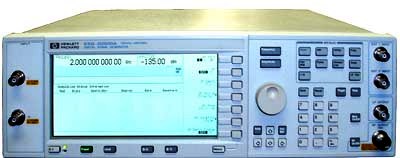
|
|
The HP E4432A ESG-D3000A Digital Signal Generator provides a wide range of digital modulation capabilities. Built-in personalities for common communication standards Internally generate pi/4 DQPSK and GSMK signals to meet the test requirements of NADC, PDC, PHS and GSM receivers. Offering a choice of internal or external data generation, and flexible framing and timeslot configuration capabilities. Flexible frames and timeslots, as well as internal burst and data generation easily configure timeslots to simulate different types of traffic, control, or synchronization channels (or bursts). Generate mobile- or base-station transmissions for a variety of digital communications standards with the internal burst capabilities. Also, the E4432A ESG-D3000A reduces the need for external equipment with comprehensive data generation capabilities. Use the analog I and Q inputs to generate the complex modulation formats (such as BPSK, QPSK, and 16QAM), required for the development and testing of RF digital communications systems. A built-in quadrature modulator processes the I and Q input signals, to provide superior modulation accuracy and stability, over a 10 MHz (1 dB) bandwidth. Extremely stable dc FM precisely reproduces digital signaling for FM receivers with selective squelch control. Wideband phase modulation capabilities are useful for satellite communications applications, offering deviations up to 90 radians and 6 MHz rates. Wide power range (+13 to -136 dBm). Level accuracies of better than ±1.1 dB for the built-in modulation formats and typically less than ±0.6 dB, ensures precise measurement of even the most sensitive digital receivers.Specifications. Frequency: 250 kHz to 3000 MHz. Burst Envelope Rise/Fall Time: <2 µs, typical. NADC Data Rates: 48.6 kbits/sec. PDC Data Rates: 42 kbits/sec. PHS Data Rates: 384 kbits/sec. GSM (DCS1800/PCS1900) Data Rates: 270.833 kbits/sec. Coherent Carrier Out Range: 250 MHz to maximum carrier frequency. Interface: HP-IB (IEEE-488.2-1987) with Listen and Talk. RS-232. Options. Opt 1EM: Move Connectors to Rear Panel. Opt 1E5: Add High-Stability Timebase. Opt 1EH: Add GSM, NADC, PDC, and PHS Standards.
|